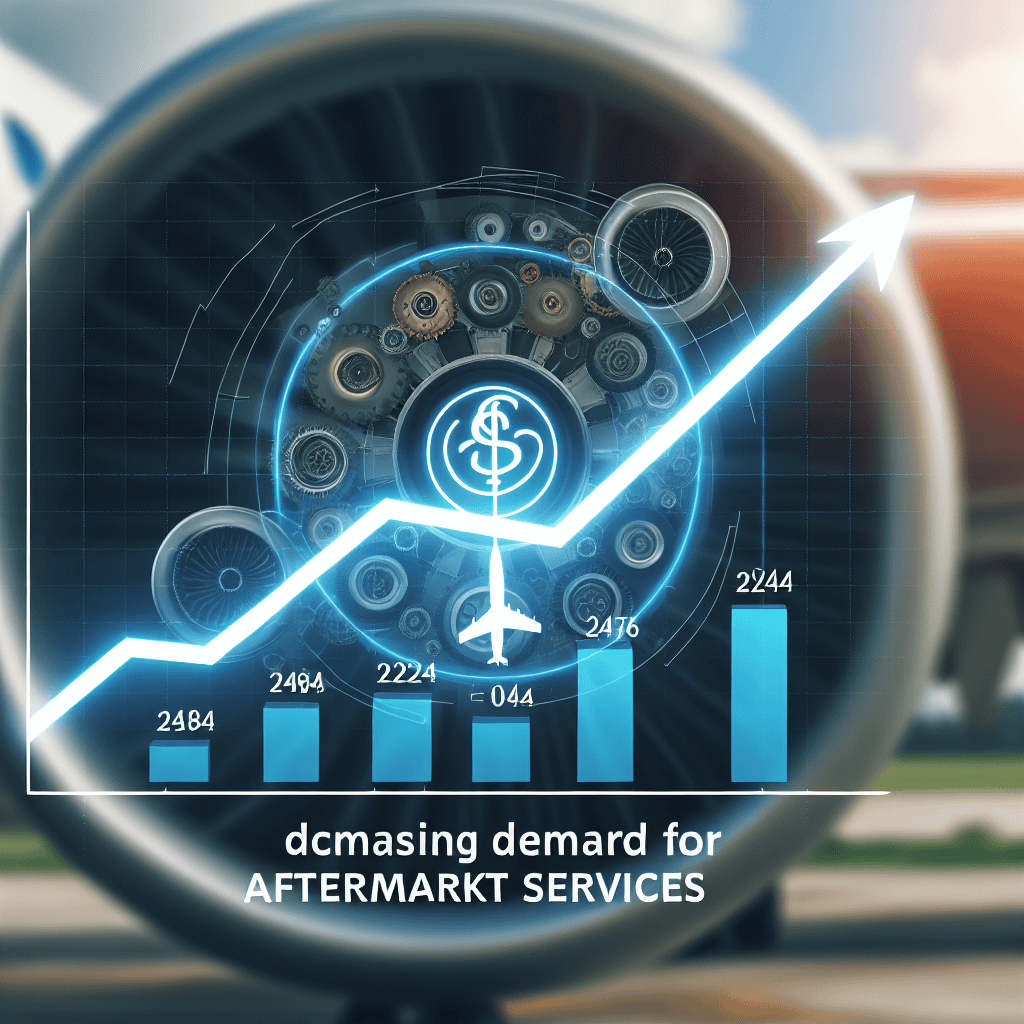“GE Aerospace: Soaring Profits with Unmatched Aftermarket Service Demand in 2024!”
Introduction
GE Aerospace has raised its profit outlook for 2024, driven by a significant increase in demand for aftermarket services. This surge reflects a broader industry trend where airlines and operators are increasingly investing in the maintenance and optimization of their existing fleets. As global air travel continues to recover and expand, GE Aerospace is capitalizing on the heightened need for engine repairs, parts replacement, and technical support. The company’s strategic focus on enhancing its service offerings and expanding its global reach has positioned it well to meet the growing needs of its customers, thereby boosting its financial performance and market competitiveness.
GE Aerospace’s Strategic Moves to Enhance 2024 Profit Outlook
GE Aerospace has recently revised its profit outlook for 2024, buoyed by a significant surge in demand for its aftermarket services. This strategic move comes as the aviation industry continues to recover from the disruptions caused by the global pandemic, with airlines increasingly seeking reliable partners to maintain and enhance their fleets. As a result, GE Aerospace is positioning itself to capitalize on this growing demand, leveraging its extensive expertise and innovative solutions to drive profitability.
The aftermarket services sector has become a critical component of the aerospace industry, providing essential maintenance, repair, and overhaul (MRO) services that ensure the longevity and efficiency of aircraft. GE Aerospace, with its long-standing reputation for excellence, is well-equipped to meet the needs of airlines seeking to optimize their operations. By focusing on this area, the company is not only addressing immediate market demands but also laying the groundwork for sustained growth in the coming years.
One of the key factors contributing to the increased demand for aftermarket services is the aging global fleet of commercial aircraft. As airlines strive to extend the lifespan of their existing planes, the need for comprehensive MRO services has intensified. GE Aerospace has responded by expanding its service offerings, incorporating advanced technologies and data analytics to provide more efficient and cost-effective solutions. This approach not only enhances the value proposition for airlines but also strengthens GE Aerospace’s competitive position in the market.
Moreover, the company’s strategic investments in digital capabilities have further bolstered its aftermarket services. By harnessing the power of data analytics, GE Aerospace can offer predictive maintenance solutions that minimize downtime and reduce operational costs for airlines. This proactive approach to aircraft maintenance is increasingly attractive to carriers looking to maximize their fleet utilization and improve overall performance. Consequently, GE Aerospace’s digital innovations are playing a pivotal role in driving the company’s profitability and market share.
In addition to technological advancements, GE Aerospace has also focused on forging strategic partnerships with key players in the aviation industry. These collaborations have enabled the company to expand its reach and enhance its service offerings, providing a more comprehensive suite of solutions to its customers. By aligning with other industry leaders, GE Aerospace is better positioned to address the evolving needs of airlines and maintain its competitive edge.
Furthermore, the company’s commitment to sustainability is another factor that is resonating with its customers. As the aviation industry faces increasing pressure to reduce its environmental impact, GE Aerospace is actively developing and implementing eco-friendly solutions within its aftermarket services. This focus on sustainability not only aligns with the broader industry goals but also enhances the company’s appeal to environmentally conscious airlines.
In conclusion, GE Aerospace’s strategic emphasis on aftermarket services is proving to be a key driver of its enhanced profit outlook for 2024. By leveraging its technological expertise, expanding its service offerings, and fostering strategic partnerships, the company is well-positioned to capitalize on the growing demand for MRO services. As the aviation industry continues to evolve, GE Aerospace’s proactive approach and commitment to innovation and sustainability will likely ensure its continued success and profitability in the years to come.
The Role of Aftermarket Services in GE Aerospace’s Financial Growth
GE Aerospace has recently revised its profit outlook for 2024, driven by a significant surge in demand for aftermarket services. This upward revision underscores the pivotal role that aftermarket services play in the financial growth of the company. As the aviation industry continues to recover from the disruptions caused by the global pandemic, airlines are increasingly focusing on maintaining and upgrading their existing fleets rather than investing in new aircraft. This shift in strategy has created a burgeoning market for aftermarket services, which include maintenance, repair, and overhaul (MRO) operations, as well as the supply of spare parts and technical support.
The importance of aftermarket services to GE Aerospace’s financial performance cannot be overstated. These services provide a steady and recurring revenue stream, which is less susceptible to the cyclical nature of new aircraft sales. As airlines strive to optimize operational efficiency and extend the lifespan of their aircraft, the demand for reliable and cost-effective MRO solutions has intensified. GE Aerospace, with its extensive expertise and global reach, is well-positioned to capitalize on this trend. The company’s comprehensive suite of aftermarket services not only enhances customer satisfaction but also fosters long-term partnerships with airlines, thereby ensuring sustained business growth.
Moreover, the increasing complexity of modern aircraft engines has further amplified the demand for specialized aftermarket services. As engines become more sophisticated, they require advanced diagnostic tools and highly skilled technicians for maintenance and repair. GE Aerospace has invested significantly in developing cutting-edge technologies and training programs to meet these evolving needs. By leveraging digital solutions such as predictive analytics and remote monitoring, the company can offer proactive maintenance services that minimize downtime and reduce operational costs for airlines. This technological edge not only differentiates GE Aerospace from its competitors but also strengthens its position as a leader in the aftermarket services sector.
In addition to technological advancements, GE Aerospace’s strategic partnerships and collaborations have played a crucial role in expanding its aftermarket services portfolio. By forging alliances with key industry players, the company has been able to enhance its service offerings and extend its global footprint. These partnerships enable GE Aerospace to tap into new markets and customer segments, thereby driving revenue growth. Furthermore, the company’s commitment to sustainability and innovation has resonated well with environmentally conscious airlines seeking to reduce their carbon footprint. By offering eco-friendly solutions and promoting sustainable practices, GE Aerospace aligns itself with the broader industry trend towards greener aviation.
As the aviation industry continues to evolve, the significance of aftermarket services in GE Aerospace’s financial strategy is likely to increase. The company’s ability to adapt to changing market dynamics and anticipate customer needs will be critical in maintaining its competitive edge. By focusing on delivering high-quality, value-added services, GE Aerospace can ensure its continued success in the aftermarket sector. In conclusion, the surging demand for aftermarket services presents a lucrative opportunity for GE Aerospace to bolster its financial performance. Through strategic investments in technology, partnerships, and sustainability initiatives, the company is well-equipped to capitalize on this trend and achieve its revised profit outlook for 2024. As airlines prioritize fleet maintenance and operational efficiency, GE Aerospace’s role as a trusted service provider will be instrumental in driving its long-term growth and profitability.
Analyzing GE Aerospace’s Market Position in 2024
In 2024, GE Aerospace finds itself in a robust market position, bolstered by a significant surge in demand for aftermarket services. This uptick has led the company to revise its profit outlook upwards, reflecting a positive trajectory in its financial performance. The aerospace industry, recovering from the disruptions caused by the global pandemic, is witnessing a resurgence in air travel and, consequently, an increased need for maintenance, repair, and overhaul (MRO) services. GE Aerospace, with its extensive portfolio and expertise, is well-positioned to capitalize on this trend.
The aftermarket services sector has become a critical revenue stream for aerospace companies, and GE Aerospace is no exception. As airlines strive to maintain operational efficiency and extend the lifespan of their fleets, the demand for reliable and timely MRO services has intensified. GE Aerospace’s strategic investments in technology and infrastructure have enabled it to meet this demand effectively. By leveraging advanced analytics and digital tools, the company has enhanced its service offerings, ensuring quicker turnaround times and improved reliability for its clients.
Moreover, GE Aerospace’s commitment to sustainability and innovation has further strengthened its market position. The company has been at the forefront of developing eco-friendly technologies, which are increasingly sought after by airlines aiming to reduce their carbon footprint. This focus on sustainability not only aligns with global environmental goals but also provides a competitive edge in the marketplace. As airlines prioritize greener operations, GE Aerospace’s environmentally conscious solutions are likely to see heightened demand.
In addition to its strong aftermarket services, GE Aerospace’s core business of manufacturing aircraft engines continues to perform well. The company has secured several key contracts with major airlines and aircraft manufacturers, ensuring a steady stream of revenue. These contracts not only highlight the trust and reliability associated with GE Aerospace’s products but also reinforce its position as a leader in the aerospace industry. The integration of cutting-edge technology in engine design and manufacturing has further solidified its reputation for excellence and innovation.
Transitioning to the financial implications of these developments, GE Aerospace’s revised profit outlook for 2024 is a testament to its strategic foresight and operational efficiency. The company’s ability to adapt to changing market dynamics and capitalize on emerging opportunities has been instrumental in its financial success. By focusing on high-margin aftermarket services and maintaining a strong order book for new engines, GE Aerospace has created a balanced revenue model that mitigates risks and enhances profitability.
Furthermore, the company’s global reach and extensive network of service centers have played a crucial role in its market dominance. By establishing a presence in key regions, GE Aerospace can offer localized support and services, thereby strengthening customer relationships and fostering long-term partnerships. This global strategy not only enhances service delivery but also provides valuable insights into regional market trends and customer preferences.
In conclusion, GE Aerospace’s upward revision of its 2024 profit outlook underscores its strong market position and ability to navigate the complexities of the aerospace industry. The surge in aftermarket service demand, coupled with the company’s focus on sustainability and innovation, has created a favorable environment for growth. As the aerospace sector continues to evolve, GE Aerospace’s strategic initiatives and commitment to excellence are likely to sustain its competitive advantage and drive future success.
How Surging Demand for Aftermarket Services Impacts GE Aerospace

GE Aerospace has recently revised its profit outlook for 2024, buoyed by a significant surge in demand for aftermarket services. This development underscores the pivotal role that aftermarket services play in the aerospace industry, particularly as airlines and operators increasingly seek to extend the lifespan and efficiency of their existing fleets. As the aviation sector continues to recover from the disruptions caused by the global pandemic, the demand for maintenance, repair, and overhaul (MRO) services has intensified, providing a lucrative opportunity for companies like GE Aerospace.
The aftermarket services sector is a critical component of the aerospace industry, offering a stable revenue stream that is less susceptible to the cyclical nature of new aircraft sales. For GE Aerospace, this segment has become increasingly important as airlines prioritize cost-effective solutions to maintain operational efficiency. The company’s comprehensive suite of aftermarket services, which includes engine maintenance, component repair, and digital solutions, positions it well to capitalize on this growing demand. By leveraging its extensive expertise and global network, GE Aerospace is able to offer tailored solutions that meet the specific needs of its diverse clientele.
Moreover, the surge in demand for aftermarket services is not only a reflection of the industry’s recovery but also indicative of broader trends within the aviation sector. Airlines are increasingly focusing on sustainability and fuel efficiency, driving the need for advanced maintenance solutions that can enhance engine performance and reduce emissions. GE Aerospace’s commitment to innovation and sustainability aligns with these industry priorities, enabling it to offer cutting-edge services that support airlines’ environmental goals. This alignment not only strengthens customer relationships but also enhances the company’s competitive edge in the marketplace.
In addition to the environmental considerations, the financial implications of aftermarket services are significant. As airlines grapple with rising operational costs, the ability to optimize fleet performance through effective maintenance strategies becomes paramount. GE Aerospace’s aftermarket services provide a cost-effective alternative to purchasing new aircraft, allowing airlines to maximize the value of their existing assets. This financial prudence is particularly appealing in the current economic climate, where airlines are striving to balance cost management with the need to meet increasing passenger demand.
Furthermore, the digital transformation of the aerospace industry has also contributed to the growing demand for aftermarket services. Advanced data analytics and predictive maintenance technologies are revolutionizing the way airlines manage their fleets, enabling more proactive and efficient maintenance practices. GE Aerospace has been at the forefront of this digital revolution, offering innovative solutions that harness the power of data to improve operational efficiency and reduce downtime. By integrating these technologies into its aftermarket services, GE Aerospace is able to deliver enhanced value to its customers, further solidifying its position as a leader in the industry.
In conclusion, the surging demand for aftermarket services is a testament to the evolving dynamics of the aerospace industry. For GE Aerospace, this trend presents a significant opportunity to drive growth and profitability in 2024 and beyond. By focusing on innovation, sustainability, and digital transformation, the company is well-positioned to meet the needs of its customers and capitalize on the expanding aftermarket services market. As the aviation sector continues to navigate the challenges and opportunities of the post-pandemic landscape, GE Aerospace’s strategic emphasis on aftermarket services will undoubtedly play a crucial role in shaping its future success.
GE Aerospace’s Innovations Driving Profitability in 2024
GE Aerospace has recently revised its profit outlook for 2024, buoyed by a significant surge in demand for its aftermarket services. This optimistic forecast underscores the company’s strategic focus on innovation and customer-centric solutions, which have become pivotal in driving its profitability. As the aviation industry continues to recover from the disruptions caused by the global pandemic, GE Aerospace is capitalizing on the increasing need for maintenance, repair, and overhaul (MRO) services, which are essential for ensuring the longevity and efficiency of aircraft fleets worldwide.
The aftermarket services sector has emerged as a critical revenue stream for GE Aerospace, as airlines and operators seek to optimize their existing fleets rather than invest in new aircraft. This shift in focus has been driven by the need to manage costs effectively while maintaining high operational standards. Consequently, GE Aerospace has invested heavily in enhancing its service capabilities, leveraging advanced technologies such as predictive analytics and digital twins to offer more efficient and reliable solutions. These innovations not only improve the performance and lifespan of aircraft engines but also provide customers with valuable insights into their operations, enabling them to make informed decisions.
Moreover, GE Aerospace’s commitment to sustainability has further strengthened its position in the market. The company has been at the forefront of developing eco-friendly technologies that reduce carbon emissions and improve fuel efficiency. By integrating these advancements into its aftermarket services, GE Aerospace is helping its customers meet stringent environmental regulations while also contributing to the broader industry goal of achieving net-zero emissions. This dual focus on performance and sustainability has resonated well with airlines, many of which are under increasing pressure to demonstrate their commitment to environmental stewardship.
In addition to technological advancements, GE Aerospace has also prioritized building strong partnerships with its customers. By fostering collaborative relationships, the company gains a deeper understanding of the unique challenges and needs faced by each airline, allowing it to tailor its services accordingly. This customer-centric approach has been instrumental in enhancing customer satisfaction and loyalty, which in turn drives repeat business and long-term contracts. As a result, GE Aerospace has been able to secure a steady stream of revenue from its aftermarket services, providing a solid foundation for its projected profit growth in 2024.
Furthermore, the global expansion of air travel, particularly in emerging markets, presents additional opportunities for GE Aerospace to expand its aftermarket services. As more airlines enter these markets, the demand for reliable and efficient MRO services is expected to rise, creating a favorable environment for GE Aerospace to extend its reach and influence. By strategically positioning itself in these regions, the company is well-placed to capture a significant share of the growing market, further bolstering its profitability.
In conclusion, GE Aerospace’s enhanced profit outlook for 2024 is a testament to its strategic focus on innovation, sustainability, and customer engagement. By leveraging advanced technologies and fostering strong partnerships, the company is well-equipped to meet the evolving needs of the aviation industry. As the demand for aftermarket services continues to surge, GE Aerospace is poised to capitalize on this trend, ensuring its continued success and leadership in the aerospace sector.
The Future of Aftermarket Services in the Aerospace Industry
GE Aerospace has recently revised its profit outlook for 2024, buoyed by a significant surge in demand for aftermarket services. This development underscores a broader trend within the aerospace industry, where the aftermarket segment is becoming increasingly pivotal to the financial health of major players. As airlines and operators seek to extend the lifespan of their fleets and optimize operational efficiency, the demand for maintenance, repair, and overhaul (MRO) services has risen sharply. This shift is not only reshaping the business strategies of companies like GE Aerospace but also redefining the competitive landscape of the industry.
The aftermarket services sector, traditionally seen as a supplementary revenue stream, is now at the forefront of strategic planning for aerospace companies. This change is driven by several factors, including the growing complexity of modern aircraft, which necessitates specialized maintenance expertise. Additionally, the global push towards sustainability has prompted airlines to focus on maintaining and upgrading existing fleets rather than investing in new aircraft. Consequently, companies that can offer comprehensive and efficient MRO services are well-positioned to capitalize on this trend.
GE Aerospace’s enhanced profit outlook is a testament to its strategic investments in the aftermarket domain. By leveraging advanced technologies such as predictive analytics and digital twins, the company has been able to offer more precise and efficient maintenance solutions. These innovations not only reduce downtime for airlines but also optimize the performance and safety of aircraft. As a result, GE Aerospace has strengthened its relationships with key clients, ensuring a steady stream of revenue from long-term service agreements.
Moreover, the company’s focus on sustainability aligns with the broader industry trend towards greener aviation practices. By providing services that enhance fuel efficiency and reduce emissions, GE Aerospace is meeting the dual demands of economic and environmental sustainability. This approach not only enhances the company’s market position but also contributes to the global effort to mitigate the environmental impact of air travel.
In addition to technological advancements, GE Aerospace’s success in the aftermarket sector can be attributed to its global reach and robust supply chain. The company’s extensive network of service centers and partnerships enables it to deliver timely and reliable support to clients worldwide. This global presence is particularly advantageous in an industry where time is of the essence, and any delay can have significant financial implications.
Looking ahead, the future of aftermarket services in the aerospace industry appears promising. As airlines continue to navigate the challenges of a post-pandemic recovery, the emphasis on cost-effective and sustainable operations will likely persist. This environment presents a fertile ground for companies that can innovate and adapt to the evolving needs of the market. For GE Aerospace, maintaining its competitive edge will require ongoing investment in technology and a commitment to customer-centric service delivery.
In conclusion, the rising demand for aftermarket services is reshaping the aerospace industry, offering new opportunities for growth and innovation. GE Aerospace’s optimistic profit outlook for 2024 reflects its strategic positioning within this dynamic landscape. By focusing on technological innovation, sustainability, and global service delivery, the company is well-equipped to meet the challenges and opportunities that lie ahead. As the industry continues to evolve, the role of aftermarket services will undoubtedly become even more integral to the success of aerospace companies worldwide.
Key Factors Behind GE Aerospace’s 2024 Financial Projections
GE Aerospace has recently revised its profit outlook for 2024, projecting a significant boost driven by a surge in demand for aftermarket services. This optimistic forecast is underpinned by several key factors that are shaping the aerospace industry and GE’s strategic positioning within it. As the global aviation sector continues to recover from the disruptions caused by the COVID-19 pandemic, airlines are increasingly focusing on maintaining and upgrading their existing fleets rather than investing in new aircraft. This shift in strategy has led to a heightened demand for aftermarket services, which include maintenance, repair, and overhaul (MRO) operations. GE Aerospace, with its extensive expertise and established infrastructure in this domain, is well-positioned to capitalize on this trend.
Moreover, the resurgence in air travel has prompted airlines to prioritize operational efficiency and reliability, further fueling the need for comprehensive aftermarket support. GE Aerospace’s commitment to innovation and technological advancement has enabled it to offer cutting-edge solutions that enhance aircraft performance and reduce downtime. By leveraging data analytics and predictive maintenance technologies, GE is able to provide tailored services that meet the specific needs of its airline customers, thereby strengthening its competitive edge in the aftermarket sector.
In addition to the growing demand for aftermarket services, GE Aerospace’s financial projections are bolstered by its strategic partnerships and collaborations. The company has forged alliances with key players in the aviation industry, including airlines, original equipment manufacturers (OEMs), and other service providers. These partnerships not only expand GE’s market reach but also facilitate the exchange of knowledge and resources, enabling the company to deliver more comprehensive and integrated solutions. As a result, GE Aerospace is able to offer a broader range of services, from engine maintenance to component repair, thereby capturing a larger share of the aftermarket market.
Furthermore, GE Aerospace’s focus on sustainability and environmental responsibility is another critical factor contributing to its positive financial outlook. As the aviation industry faces increasing pressure to reduce its carbon footprint, airlines are seeking solutions that enhance fuel efficiency and minimize emissions. GE Aerospace has been at the forefront of developing eco-friendly technologies, such as advanced engine designs and sustainable aviation fuels. By aligning its offerings with the industry’s sustainability goals, GE is not only meeting the evolving needs of its customers but also positioning itself as a leader in the transition towards greener aviation.
The company’s robust financial health and strategic investments in research and development further underpin its optimistic profit projections. GE Aerospace has consistently allocated resources towards innovation, ensuring that it remains at the cutting edge of technological advancements. This commitment to R&D has resulted in a steady pipeline of new products and services that cater to the dynamic needs of the aviation industry. By continuously enhancing its capabilities and expanding its portfolio, GE Aerospace is well-equipped to navigate the challenges and opportunities that lie ahead.
In conclusion, GE Aerospace’s revised profit outlook for 2024 is a testament to its strategic foresight and adaptability in a rapidly evolving industry. The surge in demand for aftermarket services, coupled with strategic partnerships, a focus on sustainability, and a commitment to innovation, are key factors driving the company’s financial projections. As the aviation sector continues to recover and transform, GE Aerospace is poised to play a pivotal role in shaping the future of air travel, delivering value to its customers and stakeholders alike.
Q&A
1. **What is GE Aerospace’s recent financial outlook for 2024?**
GE Aerospace has boosted its profit outlook for 2024.
2. **What is driving the increased profit outlook for GE Aerospace?**
The surge in demand for aftermarket services is driving the increased profit outlook.
3. **What are aftermarket services in the context of GE Aerospace?**
Aftermarket services refer to maintenance, repair, and overhaul services provided after the sale of aircraft engines and components.
4. **How does the demand for aftermarket services impact GE Aerospace’s business?**
Increased demand for aftermarket services leads to higher revenue and profitability for GE Aerospace.
5. **What factors might contribute to the rising demand for aftermarket services?**
Factors may include increased air travel, aging aircraft fleets, and airlines seeking to extend the life of their existing aircraft.
6. **How does GE Aerospace’s performance in aftermarket services compare to its competitors?**
GE Aerospace is experiencing strong demand, potentially outperforming some competitors in the aftermarket sector.
7. **What strategic actions might GE Aerospace take in response to this demand surge?**
GE Aerospace might invest in expanding its service capabilities, enhancing technology, and increasing workforce to meet the growing demand.
Conclusion
GE Aerospace has raised its profit outlook for 2024, driven by a significant increase in demand for aftermarket services. This surge is attributed to the growing need for maintenance, repair, and overhaul services as the aviation industry continues to recover and expand post-pandemic. The heightened demand for these services is enhancing GE Aerospace’s revenue streams, allowing the company to project a more optimistic financial performance for the upcoming year. This positive outlook reflects the company’s strategic positioning and ability to capitalize on the robust recovery and growth trends within the aerospace sector.





